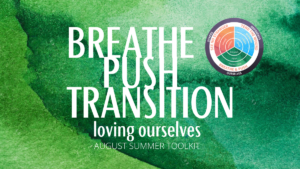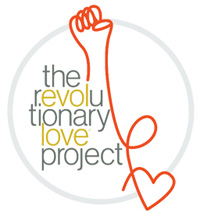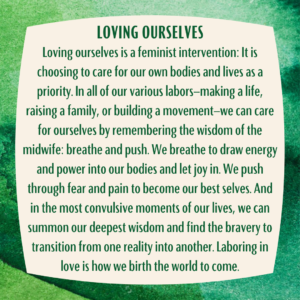Pranayama
This month: ‘Loving ourselves…breathe and push.’
August 3, 2021Valerie Kaur
Breath: A Guided Inquiry
|
|
|
|
|
Transition: Ways to Practice
“Transition is both a noun and a verb. Transition is the fiery process that is required to move from one reality into another. To transition is to summon the courage to stay in the labors of love and justice, even when we want to give up. It requires us to draw upon collective wisdom to birth something new together.”
Create a wisdom practice. Choose ways to listen to your deepest wisdom, the parts of yourselves that are wise and brave and unfailingly loving. This might mean protecting a few minutes daily to journal, meditate, draw or color or create—whatever gives you the stillness to quiet the noise of the world and listen to the wisest voice within you. If you do not yet hear anything, that is okay. Keep breathing. Keep listening.
Surround yourself with sources of bravery. Who makes you brave? These may be people in your life, or they may be ancestors, authors, artists, or activists you have never met. Keep these people and their voices close to you so that you can nourish the root of your own deepest wisdom.
Transition requires endings as well as new beginnings. As individuals we can ask: What stories am I willing to let die in order for new possibilities to be born? As a society we can ask: What stories about our nation have to die for a new America to be born?
Reflect in your wisdom journal. The wise voice in you will tell you what practice you need on the revolutionary love compass — when you need to breathe, push, grieve, rage, fight, and on. What do you need on any given day, in any given moment? Calling forth our deepest wisdom is not just how we love ourselves. When we lead with our deepest wisdom, not our fear, we can play our role in transitioning the world around us. Imagine a critical mass of people leading from their deepest wisdom: We can transition humanity as a whole.
“Joy is the gift of love. To let in joy is to give our senses over to what is beautiful, delightful, pleasurable, or wondrous in the present moment. Joy returns us to everything good and beautiful and worth fighting for. It gives us energy for the long labor.”
What brings you joy? Choose one thing that is simple and accessible. A person, a place, or an activity that you could go to right now if you wanted to.
Notice what it is about this thing that brings you joy. See it, touch it, taste it. Remember how it felt when you were fully in it. The sensation could be very strong. Or just a slight feeling. Place more attention on it. Let yourself enjoy it.
What does joy feel like in your body? Notice where you feel sensation, ease, and tingling. Place your attention there and notice what happens. Go back and forth between your source of joy and the sensations in your body.
Notice any blocks to letting yourself feel this joy. Feelings of guilt or shame? Stories about what you deserve? Call upon your deepest wisdom to speak to yourself as you would your own beloved child or best friend. What do you hear?
|
|
The Revolutionary Love Project envisions a world where love is a public ethic and shared practice in our lives and politics. We generate stories, tools, and thought leadership to equip people to practice the ethic of love in the fight for social justice.




